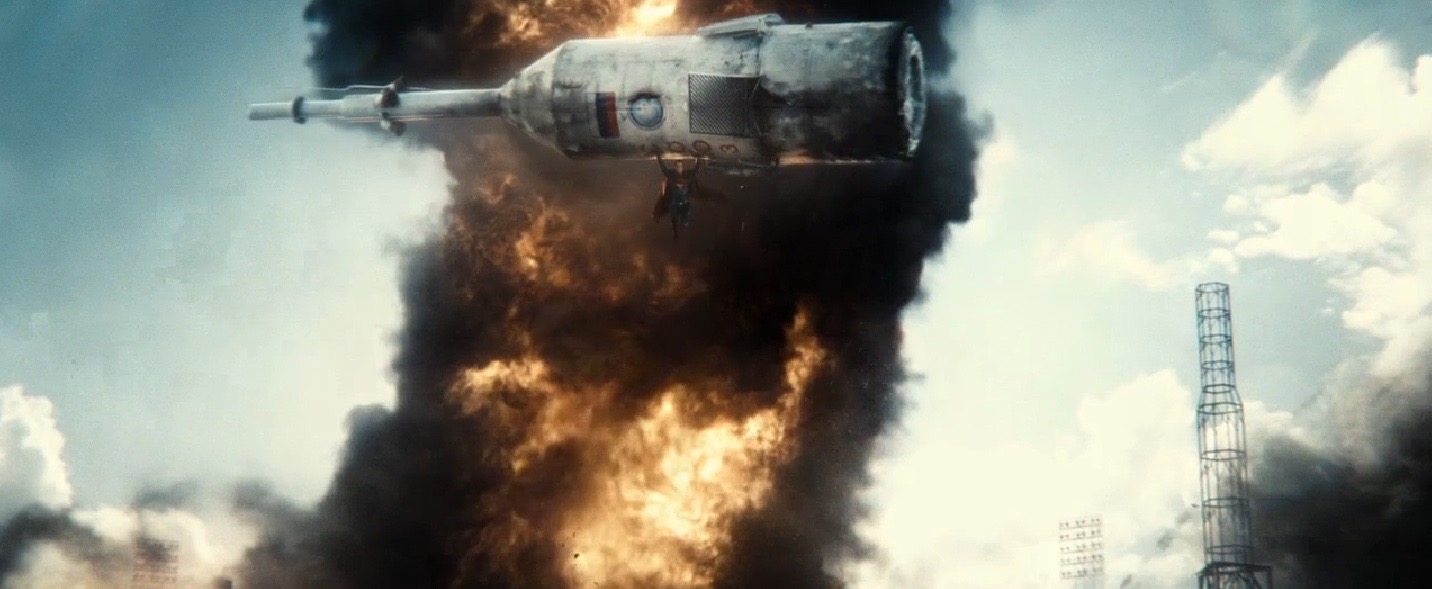
The Superman launch-abort system works yet again.
In the new film "Batman v Superman: Dawn of Justice," which hits theaters across the United States on Friday (March 25), the Man of Steel swoops in during a launch emergency and delivers the crewmembers of a Russian Soyuz spacecraft from apparent certain death, as the highly anticipated movie's trailer shows.
Ten years ago, it was a space shuttle that needed saving. In 2006's "Superman Returns," NASA for some reason attempts to launch a shuttle from atop a jumbo jet in midair — and also allows reporters to fly aboard the plane, to get an extra-juicy scoop. (Space shuttles did ride carrier jets in real life, but only while being transported from place to place; on space missions, the orbiters launched vertically, from the ground.)
This novel liftoff strategy goes awry in the 2006 movie, and Superman saves the day, as he is wont to do: He sends the shuttle on its orbital way, and prevents the jumbo jet from crashing into a baseball stadium in New York City. If you missed it, here's a clip:
The shuttle fleet was grounded in 2011, but Soyuz spacecraft are still operational. Indeed, the Soyuz is currently the only ride to and from the International Space Station (though the American spaceflight companies SpaceX and Boeing are developing their own astronaut taxis, which NASA wants to be operational by the end of 2017).
Soyuz spacecraft launch atop Soyuz rockets from Baikonur Cosmodrome in Kazakhstan. History has proven both the spacecraft and the rocket to be very reliable; Soyuz cosmonauts died during accidents in 1967 and 1971, but there have been no fatal accidents since. (Neither tragedy was caused by a launch failure, for what it's worth.)
Real-life Soyuz are built without Superman in mind, and thus have a launch-emergency system of their own — a small rocket designed to steer the capsules clear of danger should something go wrong on the pad. You can see this rocket in the "Batman v Superman" trailer, by the way; it's the long, pointy thing at the top of the Soyuz. (Apparently it didn't work as it was supposed to in the movie's universe.)
Get the Space.com Newsletter
Breaking space news, the latest updates on rocket launches, skywatching events and more!
The space shuttle program also suffered two fatal accidents during its 30-year run. The shuttle Challenger exploded 73 seconds after liftoff in January 1986, and Columbia broke apart during its re-entry to Earth's atmosphere in February 2003. Each disaster killed all seven astronauts aboard.
Follow Mike Wall on Twitter @michaeldwall and Google+. Follow us @Spacedotcom, Facebook or Google+. Originally published on Space.com.
Join our Space Forums to keep talking space on the latest missions, night sky and more! And if you have a news tip, correction or comment, let us know at: community@space.com.

Michael Wall is a Senior Space Writer with Space.com and joined the team in 2010. He primarily covers exoplanets, spaceflight and military space, but has been known to dabble in the space art beat. His book about the search for alien life, "Out There," was published on Nov. 13, 2018. Before becoming a science writer, Michael worked as a herpetologist and wildlife biologist. He has a Ph.D. in evolutionary biology from the University of Sydney, Australia, a bachelor's degree from the University of Arizona, and a graduate certificate in science writing from the University of California, Santa Cruz. To find out what his latest project is, you can follow Michael on Twitter.









